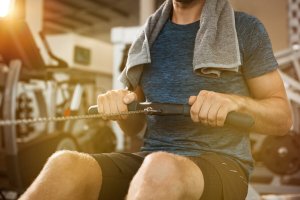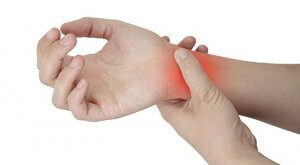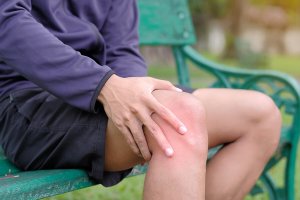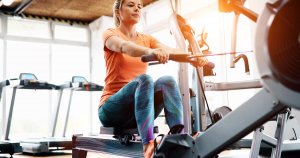Rowing: Common Injuries to be Aware Of

Rowing is an exercise that works the whole body. Therefore, it’s become popular thanks to the good results it offers to those who practice this activity. For this reason, it’s advisable to know what the most common injuries among rowing athletes are.
Practicing rowing in open spaces or using the rowing machine in the gym has many benefits for the body. Among the top are burning fat, toning muscles, improving posture and increasing blood flow.
Now, it can be a very complete exercise, it can also lead to very severe injuries if practiced wrong. In order to preserve your well-being, we’ll explain the most common injuries related to paddling and rowing. Take note and take care of your body!
Rowing and common injuries: more frequent cases
Discover more: The Rowing Machine: The Largely Unknown Cardio Device
Rowing: common injuries, damage to the wrist
Tenosynovitis of extensor wrist tendons, also known as De Quervain syndrome, is the medical term for an injury that affects the tendons of the hand. It consists of inflammation of the extensor tendons that connect the hand with the thumb.
The symptoms of this type of injury are a pain in the wrist and hands, inability to flex the fingers or discomfort when doing so, bruising or redness. The key to reducing the risk of this injury is to warm your hands and wrists very well before paddling.

Although it seems silly in comparison with other areas of the body that are used in rowing, the hands, fingers, and wrists are joints that also warrant a thorough warming up. Remember, your hands and wrists are responsible for supporting the equipment.
Rowing: common injuries and back pain
The back is usually under high levels of tension while rowing, especially during long workouts. The area that’s most affected is the lower back because it’s necessary to sit for a long period of time while applying force.
A very common back injury is a disc prolapse in the lower back, which is also called a herniated disc. There’s a risk of lumbar disc sliding when there’s a weakness, numbness or tingling in the lower back or legs. In case you’re presenting these symptoms, we recommend you visit a doctor to make sure everything is in order.

Knee injuries
The knee is one of the most important joints of the human body since it allows the mobility of the legs. Without the knees, we wouldn’t be able to walk, run and jump, among other essential movements.
In the case of the rowing machine, the knees are in constant flexion and extension. Thus, putting too much force on them or doing the exercise without warming up properly can cause a knee ligament injury, meniscal tear or femoral pain.

The risk of knee injuries isn’t exclusive for those who use the rowing machine, but also for those who practice rowing in general. Therefore, it’s imperative that you warm up well before doing the exercise. Otherwise, you expose your knees to stress that could damage them forever.
Rib fractures
Rib fractures are more frequent and dangerous than they have any right to be, considering rowing is a non-violent exercise. However, many athletes have rib fractures due to stress. Stress fractures are those that arise from the excessive use of force in those bones.
When paddling, you put a lot of effort into the rib cage, which in turn gradually wears down the bones of the ribs. Slowly, small cracks start to appear, until the rib fractures due to stress. However small it may be, a fracture doesn’t go unnoticed. Symptoms such as very intense pain or bruising are noticed very quickly.

If you have a broken rib, you need to seek medical attention immediately. Also, to avoid an injury like this, it’s essential that you keep a balanced diet, rich in iron and calcium. This will ensure you maintain strong bones. Also, always do exercises such as planks or burpees to strengthen your torso.
You might also enjoy: Rowing Mistakes and How to Improve Your Technique
In short, rowing can make your body fit and strong, but it could also lead to some really awful injuries. Always listen to your body and let it establish its own limits. Remember, both professional and amateur athletes need to care for and nourish their bodies so that they’re in optimal conditions for the sport.
It’s time for you to pay close attention to your technique while rowing. Always warm up properly before training, and make sure you’re keeping your body hydrated. This way, you can prevent injuries related to paddling and rowing.
Rowing is an exercise that works the whole body. Therefore, it’s become popular thanks to the good results it offers to those who practice this activity. For this reason, it’s advisable to know what the most common injuries among rowing athletes are.
Practicing rowing in open spaces or using the rowing machine in the gym has many benefits for the body. Among the top are burning fat, toning muscles, improving posture and increasing blood flow.
Now, it can be a very complete exercise, it can also lead to very severe injuries if practiced wrong. In order to preserve your well-being, we’ll explain the most common injuries related to paddling and rowing. Take note and take care of your body!
Rowing and common injuries: more frequent cases
Discover more: The Rowing Machine: The Largely Unknown Cardio Device
Rowing: common injuries, damage to the wrist
Tenosynovitis of extensor wrist tendons, also known as De Quervain syndrome, is the medical term for an injury that affects the tendons of the hand. It consists of inflammation of the extensor tendons that connect the hand with the thumb.
The symptoms of this type of injury are a pain in the wrist and hands, inability to flex the fingers or discomfort when doing so, bruising or redness. The key to reducing the risk of this injury is to warm your hands and wrists very well before paddling.

Although it seems silly in comparison with other areas of the body that are used in rowing, the hands, fingers, and wrists are joints that also warrant a thorough warming up. Remember, your hands and wrists are responsible for supporting the equipment.
Rowing: common injuries and back pain
The back is usually under high levels of tension while rowing, especially during long workouts. The area that’s most affected is the lower back because it’s necessary to sit for a long period of time while applying force.
A very common back injury is a disc prolapse in the lower back, which is also called a herniated disc. There’s a risk of lumbar disc sliding when there’s a weakness, numbness or tingling in the lower back or legs. In case you’re presenting these symptoms, we recommend you visit a doctor to make sure everything is in order.

Knee injuries
The knee is one of the most important joints of the human body since it allows the mobility of the legs. Without the knees, we wouldn’t be able to walk, run and jump, among other essential movements.
In the case of the rowing machine, the knees are in constant flexion and extension. Thus, putting too much force on them or doing the exercise without warming up properly can cause a knee ligament injury, meniscal tear or femoral pain.

The risk of knee injuries isn’t exclusive for those who use the rowing machine, but also for those who practice rowing in general. Therefore, it’s imperative that you warm up well before doing the exercise. Otherwise, you expose your knees to stress that could damage them forever.
Rib fractures
Rib fractures are more frequent and dangerous than they have any right to be, considering rowing is a non-violent exercise. However, many athletes have rib fractures due to stress. Stress fractures are those that arise from the excessive use of force in those bones.
When paddling, you put a lot of effort into the rib cage, which in turn gradually wears down the bones of the ribs. Slowly, small cracks start to appear, until the rib fractures due to stress. However small it may be, a fracture doesn’t go unnoticed. Symptoms such as very intense pain or bruising are noticed very quickly.

If you have a broken rib, you need to seek medical attention immediately. Also, to avoid an injury like this, it’s essential that you keep a balanced diet, rich in iron and calcium. This will ensure you maintain strong bones. Also, always do exercises such as planks or burpees to strengthen your torso.
You might also enjoy: Rowing Mistakes and How to Improve Your Technique
In short, rowing can make your body fit and strong, but it could also lead to some really awful injuries. Always listen to your body and let it establish its own limits. Remember, both professional and amateur athletes need to care for and nourish their bodies so that they’re in optimal conditions for the sport.
It’s time for you to pay close attention to your technique while rowing. Always warm up properly before training, and make sure you’re keeping your body hydrated. This way, you can prevent injuries related to paddling and rowing.
All cited sources were thoroughly reviewed by our team to ensure their quality, reliability, currency, and validity. The bibliography of this article was considered reliable and of academic or scientific accuracy.
- Cirugía Ortopédica y Trauma Pediátrica del adolescente. Lesiones en remo. http://ortopediatricayadolescentes.com.mx/remo.html
- Hosea, T. M., & Hannafin, J. A. (2012, May). Rowing Injuries. Sports Health. https://doi.org/10.1177/1941738112442484
- Thornton, J. S., Vinther, A., Wilson, F., Lebrun, C. M., Wilkinson, M., Di Ciacca, S. R., … Smoljanovic, T. (2017, April 1). Rowing Injuries: An Updated Review. Sports Medicine. Springer International Publishing. https://doi.org/10.1007/s40279-016-0613-y
This text is provided for informational purposes only and does not replace consultation with a professional. If in doubt, consult your specialist.








